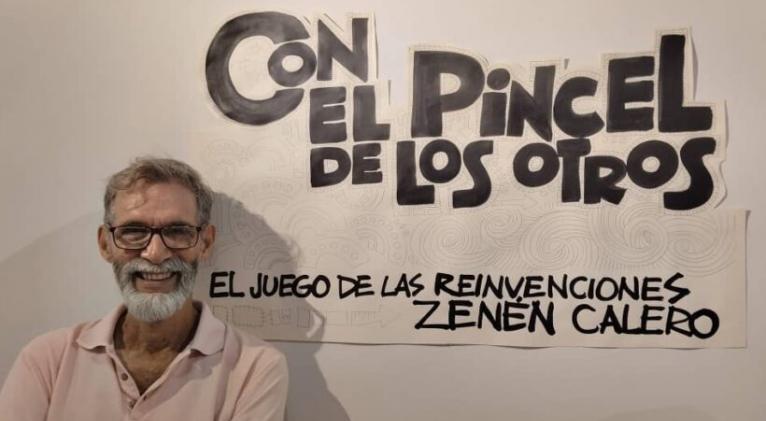Zenen Calero: “With the paintbrush of others”
especiales

These days, UNEAC Villa Manuela Art Gallery welcomes the exhibition “With the paint brush of others”, by visual artist, National Theater Award winner, Zenén Calero. Founder of Teatro de las Estaciones, he celebrates with this collection the first 30 years of doing the magic of turning dreams into real objects on the stage and vice versa.
As of the chosen title, Zenén said that it is an exhibition centered actually on the designs conceived for Estaciones based on the works of different plastic artists:
“For example, we can find the work of Cuento de Amor en un Barrio de Barroco, which we did along with William Vivanco and the Failde Orchestra, where all the visual work was done based on the painting by Luis Castro Enjamio, an artist who has been living for a long time in Spain. Then we have Pedro y el Lobo, which is made from the painting by Sosa Bravo and everything is staged there, the entire staging is there, with altarpiece, scenery, animals, all the characters and the portrait of Prokofiev.”
It is not a chronological journey, Zenén preferred to organize the exhibition based on the spaces "because of the sizes of the works and the elements that suited me with each area."
Thus, we can continue the journey through this universe of colors that populates this art gallery located in the central area of Havana until August with Flores de Carolina y ajonjolí, visually based on the aesthetics of Ares’ aesthetics: “there is the set box, the main set element, and all the photos of his original work and my work on the stage. And then, the last hall, which is the smallest, has La niña que riega la albahaca y el príncipe preguntón, all the dolls, the open suitcase, the scenery, Lorca….”
From his first design award, Zanén Calero's interest in dialogue with the work of different plastic artists blossomed, even before the birth of La Estaciones:
“The first time I did something like that was with Nokán y el maíz, in Papalote. The set design is a curtain almost reproduced from an original painting by Mendive, because the show was about the conga culture, and we worked everything from the rag dolls of those used for Santeria work. That was the opening piece of the first Cali Ibero-American Festival in Spain and here we won the design award from the National Theater Festival for children.”
More than once Zenén has been called a magician, and he is, a magician who knows well who he works for: “The artist does not create for himself, he creates for the public. You can lock yourself in an ivory tower and make a work of art with your mind, your feelings, your internal world. But once you take it out of there so that other eyes can see your work, you are already confronting another person who does not think like you and sees it with a critical look, which can be positive or negative, but it is always about what the other person thinks. You do your work for yourself in the sense that you enjoy it as if it were a child.”
That is actually the genius move, that wonder arises from this world, from the most absolute truth: “I really like to put the brakes on myself, put limits on things. For example, I have made things with two colors or just one, with what I have. I like to work with my feet on the ground, because I don't like to do double. What I have is a white wall, I don't start imagining that there are going to be seven walls and then not be able to make them.”
For Zenén, sharing is the beginning and the end: “what I like about the work of the stage designer is that it is not only my work. Theater is a collective art and I need communication between people. Since art school, I learned to feel criticism. I like people to tell me what they think about the work we do.
“A lot of people are going to see it on stage and they are going to have different feelings than what I thought at the time I did it. Suddenly, blue may mean something for me and something else for you. You have to master a series of codes so that the public understands what you are doing, even if it is abstract, so that people understand the message.”
Each artist present in Zenén's designs has been meticulously selected taking into account, first, the text, then, other motivations come into play in which the vision of Rubén Darío, Director of the company and his partner in adventure in these projects, is also involved, especially in these decades of Estaciones:
“When we went to stage La Caja de los juguetes, which was written by Norge Espinosa and is based on French Impressionism, all the color work is based on that and the use of light. The puppets had zephyr eyes, a shiny stone, at first I was a little afraid, because sometimes it gives you the idea of emptiness, of death, but then I started to analyze how to do it, playing with contrasts. In a work of a folkloric nature, like the one we did with William Vivanco, I went to look for material from people who worked with that type of aesthetics and I found Luis Castro Enjamiro. He does that work that is very Caribbean. He got the things I wanted.
“At some point, in El Gato con botas, I did a work from a story tale. That is, I have been resorting to things and searching. There are both conscious and unconscious adjustment. Pedro y el Lobo, is a Russian staging. It had to be brought here, to the island, tropicalized and, who better than Sosabravo, who is an explosion of colors, with a rhythm, with a dynamic that when you see one of his paintings, you see an impressive movement. This is how we search, based on the staging…
No one, not even the most prejudiced detractors of puppet theater, could call the artistic universe that populates Villa Manuela today as minor, because Zenen himself is the first who embraces it. He wakes up early in the morning with an idea and writes it down in the notebook next to the bed. He knows that this will be, has to be, a true work of art:
“That piece must have a value as a plastic art and that value is given by the interest, the concern, the work, the finish, everything... Perhaps in the stage, you need it to have a particular animation technique because it is the style of the work, but in the gallery, where it goes later, the goal is to save it so it does not remain in a warehouse eaten by moths. But you have to figure it out from the very beginning, from that moment it is being conceived.”
Translated by Sergio A. Paneque Díaz / CubaSí Translation Staff














Add new comment